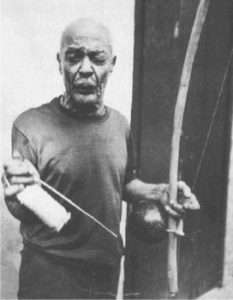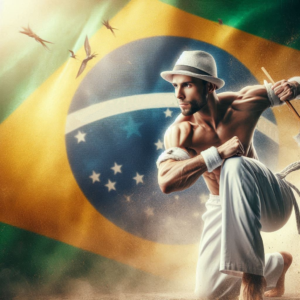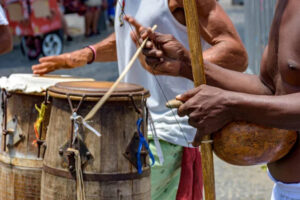Mestre Bimba
Father of Capoeira Regional

(23 november 1899 – 5 february 1974)
Don’t be afraid to get close to your opponent.
The closer you are, the more you learn.
Introduction
Manoel dos Reis Machado, better known as Mestre Bimba, was born on November 23, 1899, in the Engenho Velho de Brotas neighborhood of Salvador, Bahia, Brazil. However, his official birth date is often listed as 1900, which has caused some confusion. The son of Luiz Candido Machado, a “caboclo” (descendant of Africans and indigenous people) from Feira de Santana, and Maria Martinha do Bonfim, a Creole from the city of Cachoeira, Bimba received his nickname at birth. His mother and the midwife had bet on the baby’s sex. When the midwife confirmed it was a boy, she exclaimed, “It’s a boy, look at his ‘bimba’!” (a reference to the male genitals), thus giving rise to the nickname.
Mestre Bimba grew up in an environment where cultural traditions and martial practices were deeply rooted. His father was a renowned wrestler and champion of “batuque,” an ancient form of Afro-Brazilian wrestling accompanied by music and dance. This paternal influence was fundamental for young Bimba, who soon began to develop an interest in martial arts. From childhood, Bimba displayed an incredible determination and passion for capoeira, an art that he would transform and revolutionize over the course of his life.
Early Experiences
Mestre Bimba learned the art of fighting from his father, who was a renowned wrestler and champion of “batuque” (an ancient form of Afro-Brazilian wrestling accompanied by music and dance). At the age of twelve, Bimba began learning “Capoeira Angola” from Bentinho, an African man who was Captain of the “Companhia de Navegação Baiana” (Bahia Navigation Company). The first place where he practiced capoeira was the “Clube União em Apuros” on the old “Estrada das Baiadas”, now the “Liberdade” neighborhood. The teaching methods of the time were very tough, but Bimba excelled in his skills, becoming a formidable practitioner of Capoeira Angola.
Development of Capoeira Regional
At that time, capoeiristas were often marginalized and persecuted by the authorities. The police sergeant Pedro de Araujo Gordilho, known as ‘Pedrito’, was particularly feared by the capoeiristas of Bahia. By the age of eighteen, Mestre Bimba was already considered a master of Capoeira Angola. However, he began to notice that capoeira was losing its original characteristics, transforming into a kind of folkloric dance for tourists. Real fights based on technique and loyalty had been replaced by movements reduced to just the ginga (the basic step of capoeira) and nine kicks.
With a creative spirit and great intelligence, Bimba decided to develop a new methodology for capoeira, enriching it with new movements and more effective techniques. The goal was to make capoeira more effective, emphasizing its combat qualities. Between 1928 and 1929, he combined the movements of Capoeira Angola with the traumatic and unbalancing movements of “batuque” wrestling, learned from his father, and added movements of his own creation, thus creating the “Luta Regional Bahiana,” known as Capoeira Regional, based on 52 “golpes” (moves). This happened, as his son, Mestre Nenel, recounts, because capoeira was in decline at that time: people were discovering boxing, judo, and other forms of oriental wrestling. Moreover, capoeira was banned; so Mestre Bimba decided to merge various elements present in martial arts with the continuous movement of the body, with the “ginga” typical of capoeira, obtaining an original, effective, faster, and more competitive form of fighting.
Foundation of the first Capoeira Regional school
In 1932, Mestre Bimba founded the first specialized school, the Academia-escola de Cultura Regional, in Engenho de Brotas, Salvador, Bahia. Prior to that, capoeira was practiced and played only in the streets. However, capoeira was still heavily discriminated against by Brazilian upper-class society. In 1936, Mestre Bimba received an invitation to give a demonstration at the Bahia governor’s palace. After the successful presentation, on June 9, 1937, his academy (which had actually been operating clandestinely since 1932) was officially registered with the Bahia Department of Education and Health as the “Center for Physical Culture and Regional Capoeira”. Mestre Bimba had finally managed to convince the authorities of the cultural value of capoeira. This marked the end of the official ban on capoeira, which had been in effect since 1890.
Official Recognition of Capoeira
In 1938, Mestre Bimba began teaching courses at the CPOR (Centro de Preparação de Oficiais de Reserva) in the Barbalho fort in Salvador. The military was particularly interested in ambush techniques, which had implications for counter-insurgency tactics. On July 23, 1953, President Getulio Vargas attended a presentation of Mestre Bimba’s Capoeira Regional, declaring that capoeira is the only truly national sport of Brazil. This led to greater acceptance and dissemination of capoeira, which began to be taught in schools, the army, and the military police.
Spread and Influence of Capoeira Regional
Thanks to the work of Mestre Bimba, capoeira began to gain popularity among university students and the upper class of Bahia. Contact with other martial arts further influenced Mestre Bimba’s teaching methods, leading him to develop a new methodology that, although criticized by some as elitist, helped capoeira to emerge from the niche to which it was destined and to be valued as a sport and as an expression of Brazilian and Bahian popular culture in particular. Some believe that Mestre Bimba managed to recover the original value that the ancient slaves attributed to capoeira, making it a respected and nationally recognized discipline.
Capoeira Symposium and Final Years
In 1968, Mestre Bimba participated in the Capoeira Symposium, an important event that brought together many practitioners and masters of the discipline to discuss the future of capoeira. However, towards the end of the event, Mestre Bimba seemed disappointed by the lack of support and recognition for his work in Bahia. Disillusioned and bitter, he moved to the city of Goiânia, in the state of Goiás, in 1973. Unfortunately, on February 5, 1974, Mestre Bimba died of a heart attack. He was buried in the Parque Cemetery in Goiânia, but due to his celebrity in the state of Bahia, his remains were transported to Salvador in 1978, where they rest today. Mestre Bimba’s entire life was dedicated to the study and valorization of capoeira. Even after his death, his teachings and his commitment continue to live on, contributing to the spread of capoeira throughout the world.











